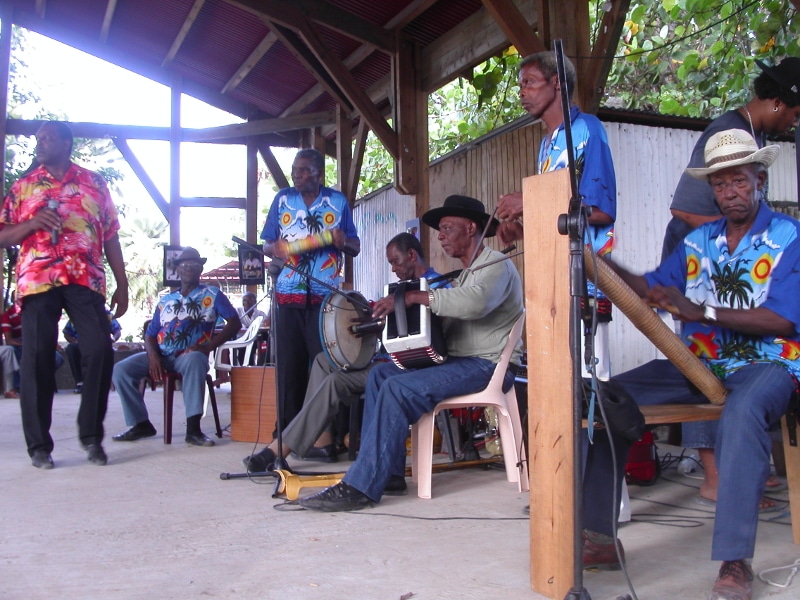Quadrille

The Music
The Quadrille in Guadeloupe is directly descended from the French Contredanse as it was danced in the 18th century.th century in Europe. A ballroom dance reserved for the nobility and the upper middle classes, it drew its lustre from the richness and originality of the costumes, the harmony of the colours and the elegance with which the dancers presented themselves.
Imported into the Colonies, particularly the French West Indies, in the same century, by immigrants from France, who occupied the conquered territories in the name of the "King" and made their fortunes, especially as the "slave trade" provided labour at will.
Practised as in Europe by the dominant class, in this case "the Masters", the Quadrille was forbidden to slaves, although some "talented negroes" were taught to play the violin.
Despite all the prohibitions, the slaves, at meetings that were supposed to be held without punishment, mocked the Masters by parodying their Quadrille dance, and soon after the abolition of slavery, the "New Freemen" appropriated it.
It is believed that the Quadrille au Commandement was created in the shallows of the commune of SAINTE-ANNE according to the codes of the ex-slaves: the Quadrille music is creolised by the addition of the violin:GRAJ also called SYAK- of the TRIANGLE- of the TANBOU DI BASS- of the ACCORDEON- of the TANBOU DI BASS- of the ACCORDEON- of the TANBOU DI BASS
The music is thus mixed, retaining certain European characteristics, but the African contribution is evident in the syncopated sound of the melodies and rhythms.
The Commander
At the same time, as the population of Grands-Fonds did not master the French language at the time, a central figure called the "COMMANDEUR" was created, whose role was to organise the dance by announcing the figures and the order in which they were to be performed. The dancers therefore had to follow the "Commandments" without ever questioning them.
The Commander is never wrong, you just have to listen to what he says, and invites you to take to the dance floor as soon as you hear : "LADIES' RIDERS
The Dance

In Guadeloupe, seven quadrilles are danced, each consisting of four figures, as in Europe: "TROUSERS" - "L'ETE" - "LA POULE" - "LA PASTOURELLE
followed by a final figure which varies according to the region (e.g. in Grande-Terre it is summer for the final).
The most popular in the region are :
- Command Quadrille (GRANDE-TERRE)
- Quadrille à la Reprise dit de BASSE-TERRE
- The VIEUX-FORT Quadrille
- Le Quadrille de MARIE-GALANTE.
NB The Quadrille "Au Commandement" is danced in a round of 8 people.
The "BASSE-TERRE" and "VIEUX-FORT" quadrilles are danced in lines of 4 or 8 people without a "Commandeur".
The MARIE-GALANTE Quadrille is danced in a line of 4/8 people and with 1 Commander.
The musical rhythms of these 4 Quadrilles also have their own particularities.
Unfortunately, for too long, our quadrille was confined to and practised by people living away from the towns, the descendants of colonists and the Creole bourgeoisie, who had a sort of contempt for "bitin a nèg", preferring the "Quadrille des Lanciers", which they considered less exotic.
Today, the tradition lives on, and is beginning to find favour with the Guadeloupean people, who are discovering this part of our cultural heritage that has been ignored for too long.
Ladies, put on your best CREOLES DRESSES, also known as "Grandmother's Dresses" or "Body Dresses", and gentlemen, your best suits, not forgetting your black hat and : "CAVALIERS aux DAMES
Media


